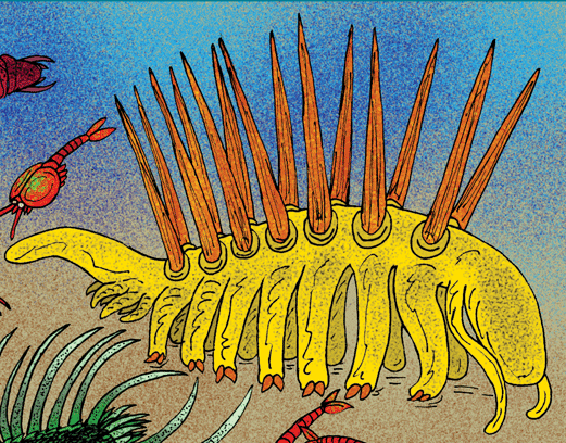Incertae sedis
By ALPER ÖZKAN (MBG/III)
d_ozkan@ug.bilkent.edu.tr
Summer has long since passed (or rather, those last few days were busy enough to make me think it's winter already. Good heavens, being a senior is harder than expected). but I still have my mind on that marine life column. All manners of creatures dwelled in the ancient seas, some so bizarre that no two scientists agree what exactly they were - when an animal is left to mineralize in a rock for a few hundred million years, it starts to look a bit like anything! And for this week, I intend to speak what little I know on those critters. I recommend having Google's image search handy for this column, since some of them truly do have to be seen to be believed.
Cambrian period marked the rise of a great variety of animals (hence the famed "Cambrian explosion" term), but the undisputed king of them all was Anomalocaris (that is, unless something even bigger is  found). The feeding limbs of the animal were first thought to be two different arthropods; its mouth was identified as a jellyfish, and its body as a sponge. It took quite some effort to realize those three animals were in fact just parts of a single, greater whole.
found). The feeding limbs of the animal were first thought to be two different arthropods; its mouth was identified as a jellyfish, and its body as a sponge. It took quite some effort to realize those three animals were in fact just parts of a single, greater whole.
The complete animal somewhat resembled a lobster, but instead of legs it bore a series of lobed "fins" that allowed it to swim. Its mouth was a series of circular plates, and it had two spiny limbs, perhaps to grasp prey. How it fed is a mystery, for while its feeding appendages and large size suggest a predatory life, Anomalocaris' mouth wasn't hard enough to break trilobite shells (that would be akin to us biting a rock). One idea is that it used its feeding appendages to bend its prey up and down, creating enough stress to open the shell. In a way, it's like eating pistachios, except with trilobites instead. I wonder what trilobites taste like.
Even weirder was Opabinia, smaller than Anomalocaris but equipped with five eyes and a long proboscis (that looks like a vacuum cleaner's hose. Wikipedia even describes it that way). The latter's function was also remarkably like a vacuum cleaner's. Opabinia probably searched the sediment with its proboscis for edible matter, and upon finding a prey item, the claw-tipped appendage was used to catch the quarry and bring it to the animal's mouth.
Yet another enigma is Hallucigenia. The description of the animal is simple: it has seven long appendages on one side, and seven pairs of spines on the other. One end of the animal ends with a featureless sphere, the other bears six more, smaller appendages and tapers off. The greatest question about the creature was likewise simple: which end is which? Several answers exist, including an old interpretation where each of the seven appendages is a mouth, and the animal walks on its spines.
I don't have space for much more, but many other interesting animals (not to mention plants and fungi) of unknown affinity exist, some later than Cambrian period, such as the eight-meter long lichen tree (or is it a fungus?). Prototaxites, alien stalked cup Namacalathus, or the submarine-like Vetulicolia, which is unexpectedly close to us humans! Modern species no less bizarre than those creatures of old are also there, like the shapeless cell mass Trichoplax or Myxozoa, relatives of jellyfish that have partially reverted back to a single-celled life. Do try to check Wikipedia's articles on basal animals once in a while!